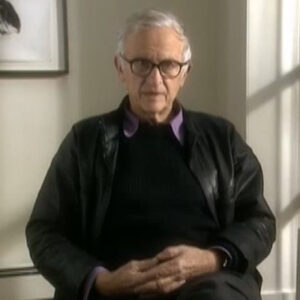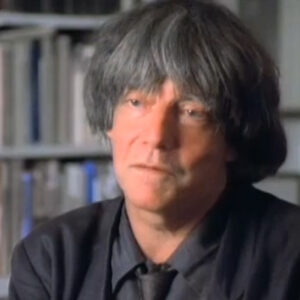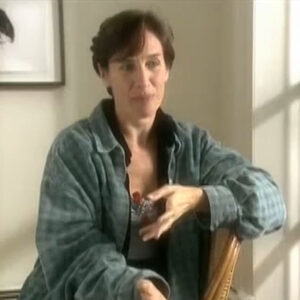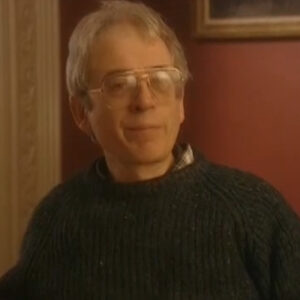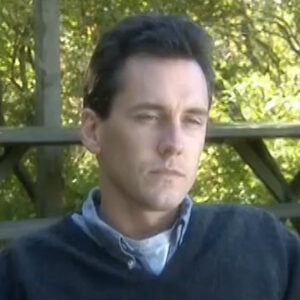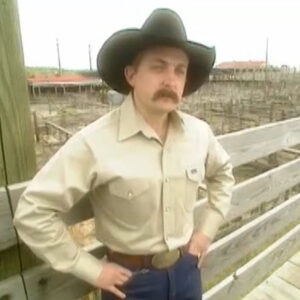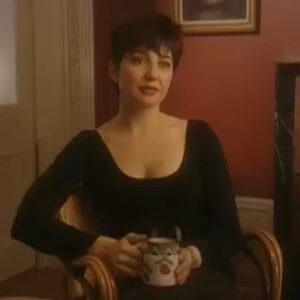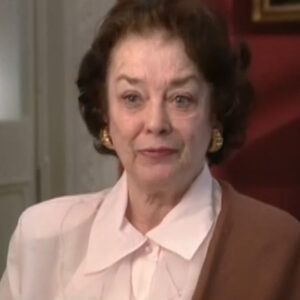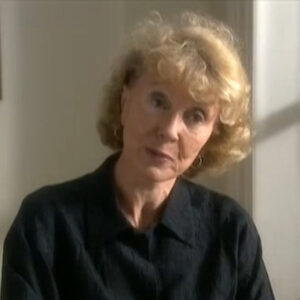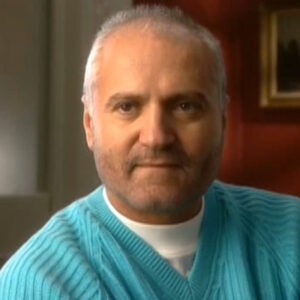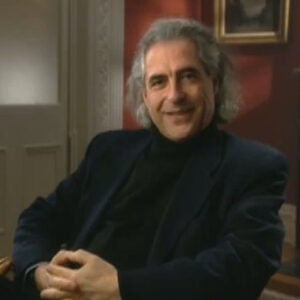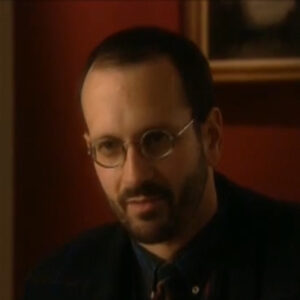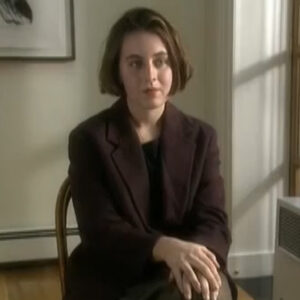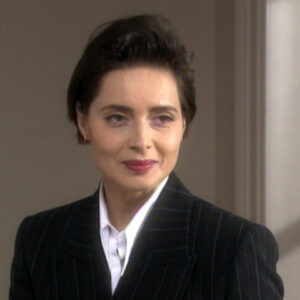Speaker I have known Dick Avidan professionally for probably 30 years. It started in the 60s when I was very young and out of school, and I got fortunately went to Harper’s Bazaar to find out if they had a job there. As an assistant to Morvan newsreel and there was a job and I was hired on the spot. I think more because of the way I looked than what I had in my portfolio, which is very insecure. What I quickly want I quickly knew that I was in the right place because I think one famous name I knew was Dick Avenal and Dick Cavett. One was that was then. Even in those days, very well known. And then Dick and I have intersected over the years in the sense that I went to The New York Times afterwards as an art director and worked as the magazine’s art director. And we worked on a book called Alice in Wonderland. And then in the 90s, we worked on a Marilyn Monroe special Fold-out in The New Yorker. So we’ve known each other over that span of time. Professionally that way, even though we were not working together continually.
Speaker OK.
Speaker I know. It’s like, OK, it’s a little crazy. It’s alright if I hold the glasses once again.
Speaker Once again. Once again with feeling. I came to know Dick Abbadon as an art director in the 60s. I worked at Harper’s Bazaar for most of that decade and then we crossed paths again. When I became an art director at the New York Times Magazine and I worked not necessarily with him so much as I did work on special projects with him. And we did a book called Alice in Wonderland. In the early 1970s and then in the 80s, I kind of intersected again towards the end and did a very special piece for The New Yorker magazine on Marilyn Monroe, The Celebration of Glamour. And that was kind of the way we touched base over the years. And so even though I haven’t worked with him consistently over the years, as I had with at Bazaar, he was somebody who’s always been in my life as a fashionable I’ve always looked at his work. I’ve always followed his work. And I’ve always been inspired by Dick’s work.
Speaker Let’s talk about this, right?
Speaker OK. In the dick. Susie Parker, Mike Nichols shoot. Which was kind of my immersion into the craziness of Paris collections. And those days, they were still the couture. This was the early 60s. And Dick, who had really made Susie Parker his icon.
Speaker Susie was the great beauty. Photographed by Dick. And a very sexual beauty and a very kind of a different kind of look than most of the other fashion models where Dick was always pushing for that different look. Dick was always pushing for some sexuality. Some difference. And at the same time, what was going on in the world was this explosion of paparazzi interest in Elizabeth Taylor’s romance with Richard Burton.
Speaker Which all happened around that time of Cleopatra. And one of the great things about Dick. And one of the things that interested me. I was always interested in film and what was happening in the film world and trying to bring those images into the magazine.
Speaker Dick, also long before we met, seemed to have a fascination with the world of the actress whole expression, and almost had the most innate talent to be a film director with stills of anybody I’ve ever worked with. So when that happened, he kind of got very excited about this extraordinary phenomena that was, you know, grabbing everybody’s attention throughout the world. And he decided to put it into the pages of bizarre. And we talked about how to do this. But mostly, I must say that what I think happened was he started collecting a lot of paparazzi magazines and I started collecting a lot of paparazzi magazines and we kept showing them to each other and each was more outrageous. The next, with sexier, crazier pictures and everything that had never been done in the pages of high fashion magazines.
Speaker And we went to Paris and he created a theatrical production around the idea of Mike Nichols, if you can believe it, playing playing the part of Richard Burton and Susie Parker, supposedly standing for Elizabeth Taylor, being hounded by photographers. No place to hide. No, it was about celebrity and it was it. And it’s interesting how present it was, because this is the 60s. Back then, there were there were some moments of privacy allowed to, you know, in the celebrity hood. Now, of course, there is none. There was no Oprah then. There was no hard copy then, so that he decided to go all the way and wanted to do pictures of of them fighting. He wanted to pictures of them running from paparazzi, hiding. And even one of the most famous pictures, most difficult pictures we got published was when Susie Parker looked like she was being taken out of a hospital with two nurses on either side of her and her wrists in bandages. And that was supposed to have been a suicide attempt. Now to put that into the pages of Harper’s Bazaar, which was a pretty gutsy thing to do. And I think we got away with it because Dick was very seductive and able to convince editors, even though they were crossing themselves about the danger of all this. They allowed it to happen because he has enormous taste. And even though things are out of control, he manages with his level of taste to pull it right back to just the edge of where it works. And I think that’s one of his great contributions in the world of fashion. He never sit still for what has been done, and he’s always looking to push it further. This certainly had never been done before. Whether it got well received or not, I don’t know. And my role was to take these layouts and make it look like a proper writing magazine, which was the fun of what I did. And again, it had never. It had never. Nothing like that had looked like that in a fashion magazine. There was one particular moment I remember very well with Susie Parker. Maxime’s was was taken over for a morning and Susie was in some very expensive three thousand dollar couture dress and she was put at the top of the stairs and tons of people were supposedly screaming at them and rushing at them.
Speaker And Dick kept saying, push harder, push harder, further, further down the stairs, Susie run down the stairs and Susie ran down the stairs and tripped.
Speaker And she’s such a great performer that she tripped and stayed with the part. And so did Mike. And that was the moment that we chose when we looked through the context to put on film. And I think there were two or three other little ones. The company did. But it was an incredible morning because it was truly almost out of control, which I think is what makes Dick excited. And in a way, it made me excited to be almost out of control and be able to publish it in a high fashion magazine. It was fun in those days. So I think the you know, the important part of that shoot for me as an art director was that I could support what he was after as a photographer, which was let’s take the world outside and bring it into these pages.
Speaker Let’s, you know, let’s put some air into these pages of looking stiff and stayed.
Speaker And let’s bring the life of the 60s into a fashion magazine from the street into the high fashion world. That’s what he did.
Speaker You know, the cars of some of those overtaking everybody in the crowds.
Speaker OK. In that moment when we were doing this, Susie Parker, Mike Nichols shoot in Paris. Every time that day created a scene which was supposed to end up being a particular picture on a page. Those scenes were so orchestrated with so many people, whether they were sometimes they were the taxi drivers who didn’t speak English. From from from Paris. Sometimes they were assistants. Sometimes they were just friends of friends. In fact, an old boyfriend of mine was. And what scenes and what happened was that Susie Park was put into a car and and literally it’s funny. It reminds me now what’s probably happened to Princess Di. I mean, the chaos, the out-of-control, the shoving and pushing. And Dick was himself so involved that he almost lost his camera. I remember that it almost kind of popped out of his hand. He no longer had his assistants around him to even tell him what to do or what focus was good or bad. But he just kept on shooting and everybody just kept on pushing and shoving. And the hysteria was really as close to reality as I’d ever felt in any shoot. And that’s part of what you see in.
Speaker You see the distance full circle back on deck. Yes. Interested? When pictures are about. Fashion is a way so impressive effort, but which I wish I had. She’d. Real content into so many disparaging figures.
Speaker Feel the excitement of the paparazzi and the humour of them, like Nicole’s casting. Elizabeth Taylor. Do you think he was trying to save for these pictures?
Speaker This is a program like Nickols speeches.
Speaker For privacy and celebrity.
Speaker And I hadn’t really I hadn’t really given it much, you know, a great deal of thought, but I think in looking back on those pictures in the region, that one or two of them stand up and they don’t all stand up. They really were of the moment. Those pictures. But they they left a little bit beyond the moment because of what’s happened to the idea of privacy and celebrity. And I think that the dick was very interested in people who were public figures and tried to find, I guess, some kind of some kind of way of understanding how their private life became mixed up with their public images. So I think that he was interested in the drama of if he meant Suzi Parker to be Elizabeth Taylor. And he met Mike Nichols to be. And they were out supposedly in Maxime’s. They might have a fight and he might throw champagne in her face, or at least that’s Dick’s fantasy of the reality.
Speaker So I think that kind of became closer to closer to fact than not when you realize what in fact happened to Richard Burton, Elizabeth Taylor and their own personal lives became dramas that could have been on, you know, could it could have been a TV movie week or could have been their own film. I mean, their drinking problems, their fights, all those things happened. Well, after Dick had a sense of trying to explore how that that crossed over between the private life and the public image. And I think he found that fascinating and puts it put that into his pictures, explored it. They weren’t all there. But beginning of that exploration, I think, in that series of pictures.
Speaker Let’s talk about the Iberia’s shoot. And again, the genesis of it.
Speaker What we see in those pictures.
Speaker The Iberian pictures, which were pictures taken in the early 60s, again, were a period, I think, of exploration where two things converged, which were fascinating. One, it was just the beginning of sexual liberation of women in. And I don’t mean to sound that in a political sense, but Dick had always been interested in finding a new way to make women look and stand and be and coming out of the 30s and 40s and 50s. There was an enormous change that was happening in not so much the world of fashion, but in the world. And he wanted to bring that into the pages of fashion magazines like Bazaar, which is always supposed to be a little bit ahead of what was happening. The. Therefore, there was a divergence of enormous sense of sexuality and freedom for women, as well as this incredibly new, strange, isolating vision of Antonioni, which is happening as Antonioni did a film beloved tour. I don’t even know if it was around that time. I think it was. And there was. It’s incredible that there was this extraordinary vision of women and men losing each other, finding each other, being very independent together. And at the same time, you weren’t sure, you know, who for the first time had more power over the other the women over the man or the man over women. And Dick was, I think, quite fascinated with that as well as I was. I was really interested in Antonioni sensibility of releasing a new woman onto the world stage. And that’s what that’s what brought us to the Iberian look of those images, which are dark and brooding and strange and full of kind of decadence, but a decadence that was seemed to be more power driven by the women in the images than the man. And if you notice, the two women and a man, the two women are twins, fabulously beautiful Spanish aristocrats, Nathi of Ivan Skull and her sisters name I can’t remember now. Forgive me, they were not identical twins, but almost identical. And instead of just taking two women on a trip, which would have been fascinating enough, it looked like one another. Dick thought about the snoo sexuality and decided to inject a man into this moment so that you had three people traveling together, one man and two women. Very, very difficult, subject to deal with, certainly in it in a national publication, like a fashion magazine. What did it imply that implied that in all kinds of crazy things were going on sexually between them, even though there wasn’t one sexually explicit picture? And that’s what was fascinating about it. It implied that these two women somehow had had more going for them in terms of their independence than the man. It seemed like the man was there. The man was there for their pleasure rather than the other way around. And this is all implied. Again, it’s all subtext in the pictures for me. What was after all of that it said? What interested me is the pictures are very beautiful. They’re elegant. They are beautifully described. The relationship of Dick took those on location, the relationship of his brooding sky to this strange undercurrent of passion and repression that was going on in the pictures was all kind of all worked as a piece. And that’s what I think is, again, the great contribution of Dick, is that he always brings in the life of what’s going on outside of the pages of that moment in fashion and makes it a more universal statement. If when it works, sometimes it doesn’t.
Speaker How are the pictures seen?
Speaker Both inside and outside the city. Yeah. Is there resistance inside the magazine to spread?
Speaker There was great resistance in the Iberian pictures because I think no clear. I think I think in those days, airlines kind of paid well. I think the airlines might have might have wanted. They wanted their plane to be displayed as a way of showing that they helped with the trip. And I think they demerge quite instantaneously about wanting the plane to be displayed with these three people embarking together. All in white suits. It’s one man, two women. I don’t think they like that message at all. So I. I remember there was a great conversation about I think we airbrushed out the plane’s name as far as the attitude of the editor in chief, who is very conservative and and kind of wonderful woman in the sense that she allowed things to happen, but she hated it. So in the case of those pictures, I think she was very, very frightened of what her friends were going to say around the dinner table. But she allowed them to happen. And I don’t remember any great fuss about them after the fact. Nobody, you know, no great amount of letters at least that came to my attention. Perhaps Dick has had some that I’ve never seen, you know. How dare you do this disgusting thing, whatever, from some extremely conservative types who wanted their images of women to be still very, very, you know, not isolated. I’m sorry to to be very iconographic about women who are untouchable and women who are perfect and women who are on a certain level above the level of sexual.
Speaker I spoke to the actual so bad the trip itself.
Speaker No, I’m afraid I don’t have any anecdotes to share with you on the.
Speaker Christina Polaski.
Speaker Let’s talk about that. Let’s see why the rosary beads and the. Well, through that picture of what it was and how Brown in the response to it, it almost ended up in the washer basket.
Speaker Well, Christina Palazzi was one of the really emerging and kind of the hot mover and shaker type of young socialites at the early early 60s. She was out and about. She was everywhere. She was the girl of the moment. Before, that was probably a phrase that was coined. And she was also she was a very gutsy, very audacious and and and had a kind of height, high spirit about her. She wanted to defy a lot about where she came from. I guess in terms of her elegant background and Dick. Asked one day, I think I don’t know quite how that happened, but he asked her one day and she agreed to pose nude for him. And instead of in the days when you can remember all those fashion magazines, it was never a fashion magazine. It was only a girlie magazine that showed somebody and gave their name, even if their name was Bambi. You know, whomever they nobody ever in the world of high society posed nude. When you think about it’s laughable because, of course, that happened throughout history and in art. And nobody blinks. But to think about and photograph it all of a sudden tends to to go towards the pornographic. And I think Dick wanted to break that taboo. And if I recall, the picture was taken of Christina down almost to the pubic area of her. She was completely frontal. She was dazzlingly beautiful. She looked like, you know, Venus rising from the half shell in her in her sense of herself. She wasn’t hiding anything. She wasn’t trying to to. She was trying to reveal her body and move and reveal her freedom. Again, it was about women’s freedom, which is really kind of the theme that happened in the early 60s with Dick and his pictures of women. And what happened was, of course, the the editor who was a very Catholic religious woman, took out her nerviness and said prayers. So she couldn’t believe this was happening and she couldn’t believe that this was a picture that Jack was presenting to her. And I wanted her to run and that he believed in it fully. And when Dick believes in something fully, it’s very hard to back off because he really makes a very good argument for it. And from my point of view, it’s always been about photography. Just to digress a second, that I think the really great photographs. As in great films aren’t known at the moment that you see them. They’re known many years afterwards when they’re reviewed and you begin to see what they really stand for. And I think that’s certainly true of photography. In the case of Christina Palazzi, the picture wouldn’t have run. It would’ve been in the trash basket because Nancy White hated it so much and was offended by it in every sense. Christina wanted it. I think that helped, too. And she won her name on it. And a poem was found by a very wonderful fiction editor to go with it. I think it was about beauty with some excuse to run it. It was hard. It was a pretty lame excuse, but it did find a way to make Nancy rationalize that she could run it. And so it ran and it created an enormous stir. And the funny story that I heard afterwards from more of an Israel was after that picture ran. There was a line of socialite’s to Dick studio knocking on his door to say, when can you take my picture?
Speaker When can we please, please take my picture.
Speaker I want you to take my picture, take my clothes off, do anything for you. And I don’t know where those pictures are. I hope there’s no place in the drawer that he’ll pull out someday.
Speaker And more with Israel as well.
Speaker Why should you just the what you know about those two men? And then there they can really affect not only on how magazines were designed, but on Dick.
Speaker Um, my relationship to Aleksic broader, which is is is a pretty tenuous one because I knew him through more of an Israel thanks to Morvan Israel, who hired me at Bazaar. I found out who Aleksi brought, which was I was a student of art in school. I never studied graphic design. And so let’s Radovich, surprisingly enough, which which is a terrible thing to admit. Never was brought up in my school education. His name was never brought up. But but what I think the greatest legacy for me that more than expose me to was that Radovich believed that the art of art direction, which sometimes Morvern referred to as one step further than window decoration. But the art of art direction was the subordination of the art directors abilities. To put something down on a page to the power of the vision of the artist so that it was much something like kind of a sense of when you do a musical piece, it’s about it’s about flow. It’s about beginning, middle and end. It’s about putting images on pages that relate to what came before it and what comes after it. It’s about impact and it’s not about a signature style of the art director that would in any way overwhelm the vision of the artist. And I think that’s what I got from Marvin in his sense of art direction. We always made type rather small, rather discrete. We didn’t put type, you know, running all over the pictures. We weren’t trying to obscure a photograph. We were trying to elevate, present and give as much impact as we could to the image. I mean, I am a firm believer in the power of the image. I was then and I still am now. And the best thing I can do as an art director is to allow the imagination of the photographer from the very conception of a shoot to run as free as it can go to say something or nothing during the shoot. Sometimes if you just say lighter or darker, that’s enough. You don’t have to describe what you see in front of the camera, what you’d like to see. That’s up to the photographer. And then it’s to take a look at these images in contact form and discover something else that you never thought was even in there. Hopefully discover something else and put them down on the pages and and make them have a kind of strength that they would have ordinarily if you just left them alone. But sometimes I think photographers are their worst editors. They don’t always edit their own work well, because they are there on the on the shoot and all the emotions that are connected to the shoot go with them into the lab and into looking at the photos. I frankly have always regretted that I haven’t been on so many shoots. But on the other hand, I think it’s a pure way of judging the images. I’m not emotionally involved whether this was a photograph taken by somebody hanging off a cliff and therefore we have to run it because that was a terrible moment. I’m looking at whether the image comes off on the contact sheet and probably that’s given me a perspective that’s helped me in a lot of cases. It’s made my life less fascinating as an art director. But it’s maybe given me more freedom.
Speaker What I know about abroad, which is f us, it’s very it’s very limited because from what I understand, he spoke in riddles, kind of like reland.
Speaker And the the way that most of his students interpreted them were to this day kind of argued that, you know, whether whether Radovich ever said do this or do that. I don’t I don’t think he did. I think what he said is this is bad or this doesn’t move me or this is or I’ve seen this before, go out and do something. I’m sorry that I haven’t seen before. I think the way that brought up, which influenced Dick and I say this only as an observer because I wasn’t there and I’ve never discussed it. Which is sad in a way, but it’s true. We don’t we’ve never really talked philosophically about his photographs. Maybe that’s just the way it is when you work together with them. You just do the work. But I think that Dixon. Well, Dick’s ability to be influenced by a broader vision, broad of finding and take the perfect student and the perfect person to express his desires and needs in photography. Was it broad which never settled for images that he’d seen before and he never settled for images that belonged in the place that they seemed to be right to be it? That’s a crazy sense. But in other words, if he was if he was thinking of photographing or wanting a photograph for a style magazine, a high fashion magazine, I think he’d like probably tell somebody to go out in the streets and go to, you know, go to the most unlikely place or a circus and take a high fashion magazine, take a high fashion person like the dog VEMA and the elephant picture, which in my mind probably is an expression of everything that broader vich tried to offer Dick as pushing the envelope, pushing, you know, being more powerful in the image, making the making the image unforgettable. And the reason that the image had to be unforgettable is because you are in a magazine that calls for your attention and those days of cultural change in less than it does now, because now there’s this media bombardment on all levels all around us, both in print and in film and television. But I think that broader Vic was fascinated with bringing all the levels of visual experience together into a fashion magazine. I think that also his genius was that he could take somebody like an accident and press him into being somebody who really, as a photographer, enacted being a performer and brought out the best performance in the people in front of the camera. And the best performance in himself in terms of what he felt and saw and excited him about any subject matter that he was drawn to. And Dick is drawn to people. That’s his subject matter. Not a tree, not a rock, not a piece of jewelry. People. Human experience. Hero, on the other hand, who, you know, Radovich also mentored, loved trees and rocks and shoes and inanimate objects. And I think that’s the genius of rotifers that could take any one of these threads and force the talent out into a much broader, much broader, more explosive, more and more singularly provocative vision than they would have had without him. And I think that’s one of his great legacies. Alice in Wonderland is a little strange phenomena as a project. I was working at sea. I had left in New York. No, I had left. Bizarre. And I think I was on my own at that time. Maybe just beginning to try to do some work in a in an agency. And Dick and I were not working together. He called me one day and he said, you have got to come and see this extraordinary play called Alice in Wonderland, done by a man named Andre Gregory. It’s it’s one of the. He says one of the bravest, most interesting, exciting things I’ve ever seen. And I am going to record it. He said from beginning to end to preserve it because he knew like a ballet performance. It’s never going to be preserved. Once it’s over, it’s over. And it’ll only be in the memory of those people who see it. And certainly it was never going to be performed by that same group again year after year. And I suppose they didn’t have enough money to have it filmed. Actually, when I think of it. So he took it upon himself to to make a project out of recording this phenomena and experience. And he asked me if I would be the art director of it. And I went to see Alice in Wonderland. And to be quite frank, Alice in Wonderland is one of those books as a as a as a Grown-Up. I don’t understand. As a child, I certainly didn’t know just that. I mean, I find it utterly confusing, but compelling. And that’s because it’s really it’s really involves all the terrorists of childhood and all the terrors of adulthood. It’s about a descent into of. So it’s about a descent into a kind of world where everything’s upside down. Literally an adult to you, you should trust aren’t trusted. And people who are called queens say off with your head and everything is is really frightening, but intriguing. Children are frightened and at the same time intrigued. I don’t know what you know, what the ultimate message in Alice in Wonderland is, except that it is a constantly interesting because it is somehow touching some truth about our real fears and our loss of control. So Dick, who I think is a man who is very interested in control and loss of it and is interested in those things which frighten him the most and which fascinate him the most, things that have to do with great beauty, great, you know, isolation of great beauty genius, the isolation and genius talent and what that really means. I think he he was drawn to Alice in Wonderland because it was an expression of something he needed to explore for himself. I went to some of those shoots, fortunately, and watched him meticulously and with great reverence. Photograph these actors who I think would be doing a lot of exercises in advance. They came from the Grotowski, I think, School of Theater and their bodies moved actually like dancers in preparation for this very energetic and and and and punishing play because they threw themselves at each other. They hurled themselves through the air. I think he was fascinated with that as well, that their total control and their total out of control ability. Fascinating. And to capture that on film, I mean, still film was it was a pretty daunting experience, but he did it faithfully. And then when we had all the photographs, he said, I don’t know why you shouldn’t do it, but I know that I want the energy and I want the excitement and I want the and I want the record of this experience to finally appear on the pages. But how you do it, I don’t know. Then you walk out of the studio and I’d be there alone with all of these pictures surrounding me on the floor not knowing what to do. And so I worked several nights and and more and nothing was happening. Everything was kind of awful. And I got very frightened and and I didn’t want to say that I did know what was happening. But I think he got the message that nothing was happening.
Speaker And he just kept saying, I’ll be back. I’ll be back in three hours. Just just press on. Press on. That’s what he would say. And I pressed on and nothing happened.
Speaker And then one day I took these pictures and in kind of desperation started to blow up certain faces and and started to come in on certain aspects of of when they were moving, when they were racing, when they were when there was a moment that you could almost zoom in on if you were in a film. And I put them down in sequence and he came back and he was ecstatic. And I was relieved because he just said, that’s it. That’s what I want. I. You’ve got it. You know, just keep doing that. Keep keep keep finding ways that were appropriate to the action that you could come in on. And what I did was something very unusual. I sort of destroyed the Dick Cavett on cropping of the master and took it upon myself to crack them further. And I was very frightened that he would be really angry. And he wasn’t he was pleased that he was excited and he was grateful that it went in that direction and sort of for him helped him discover released some of the control that he had with the camera. It kind of exploded the image on the page, which is what he wanted. So the funny part of that book is, of course, as you know, most people know it was a disaster. It didn’t sell. Nobody cared about it. It was a tiny little book. But he was very proud of it. And I was actually very proud of it because I really respected the impulse, which was to record this great theatre piece. And in fact, there is nothing of it except this. And that is kind of wonderful. Oh, I think maybe they might have done something since then. Perhaps they did as another version of it years later.
Speaker It might be on television much.
Speaker Yeah, you know. Yeah, that would be interesting, you should ask Andre.
Speaker Really, no pictures of the genesis of those pictures, your challenges, are those pictures, your role on that?
Speaker OK, the Marilyn Monroe pictures. It’s a it’s a kind of a small little little slice of time in history. I mean, at that point, this was now in the mid 70s. I was working at the New York Times magazine. And Dick called me one day and said, I have these extraordinary drawers full of pictures of Marilyn Rowe. A lot of them haven’t been seen before. A lot of some of his pictures of Monroe had been seen when he made her the heroine and dressed her up in different great, great women’s roles. That’s Cleopatra as Theda Bara as Jean Harlow. And they ran in Life magazine. But he also took many, many other pictures of her which were never published. And I don’t know quite what came into his mind or why, but he said I think he should be seen. And I think I’d like you to come over here and look at all this with me and let’s figure out what we can do. And I happily leapt to the to the occasion because I was looking at all these pictures of death and destruction, Vietnam. So I was really happy to be looking at Marilyn Monroe, even though I have to confess, Monroe is not my favorite actress. I frankly was embarrassed by her. I was one of those women who looked at her wiggling around on the screen and thought, what a joke. I didn’t think she was an extraordinary talent. And I thought she was just some man’s fantasy gone wrong or maybe right. But I must say, that’s all change, which is kind of lovely about what time does. When you look at images and when you think about people, which is why I think images are so powerful in the hands of people like an artist like Dick or any artist, because your sense of those people do change over time. If you had lucky enough to have the images of them remain because you receive them, they were a little ahead of their time in a way, or maybe just the nobility of their passing. Those images have more meaning. At any rate, she was a joke to me and I looked at all the pictures and they were wonderful. They were pictures of her funny pictures of her doing silly things on the floor with hats and half naked. And apparently he told me he used to have to get her or she needed to get drunk with champagne in order to do things in front of the camera. But the marvel of Monroe was no matter what that level of stupor was, she always hit her mark. And he told me that, too, was amazing. She knew where she was supposed to be and how that body was supposed to look and how his legs were supposed to be held to enhance her image. So we did this 30 or thirty five page kind of funny, humorous combination of images of Monroe never seen before and tried to peddle it to interest some publication in it. We never thought of it as a book or he never thought of it as a book. I always wondered why not. But at any rate, nobody was interested. What’s to be in mid 70s? And even though Monroe is big, big, big name, nobody at that point wanted to do it. He put it in a drawer. And fast forward 15 years or so later. He called me up in the 90s. Since just a year ago and said The New Yorker’s doing a special Hollywood issue on particularly John Laws, writing a piece on glamour, the images of glamour, what glamour is. And he said, I pulled out your Marilyn Monroe montage from the drawer and found it, as, you know, as exciting today as it was then showed it to New Yorker. They loved it. And we’re going to do the first pull out. The New Yorkers there fold out the New Yorkers ever done. So the interesting thing to me about that is an art director is I was very flattered naturally, and I’m very puzzled because I thought, well, now what am I going to do? I’m going to have to improve on these. I would have to make them better. And he said, here are all the pictures. And by the way, they were taken in color and we transform them into black and white. He said, Here are the pictures. Take a look at them. There might be some that are better than the ones that we’ve chosen to use, go often and come back with something. So I went off and I came back with some changes and he hated it. And I was sort of taken aback and said, What’s wrong with me? Isn’t this an improvement? And when I walked off again with it and looked at it, I realized it really wasn’t. And what I realized about the mom and wrote pictures that I think he liked so much, the way that I took them and combine them was I think Dick basically is a film. Who has a sense of movement in stills? I think he said very often himself. There isn’t any one picture that can express what what what a human being is it at any given time? Is it? That’s one of his frustrations that you almost need to see more than one, which is very often what he does in his photographs. He takes more than one picture and puts them together and feels that’s a portrait of somebody or you see the same person popping up in a book many, many times. And I think he really, truly feels that frustration and it manifests itself in the way he chose his work. And so in Monroe, I realized that a lot of those photographs also needed to be together of her bumping and grinding and moving and sometimes looking like like a sex symbol and sometimes looking like a really lost child and sometimes looking, you know, wicked and sometimes looking satirical. And all of those faces and all of those expressions and all of those body movements together made a Munro statement rather than any one. And what fascinated him was that I was able to do that and put it together. And it didn’t look forced. It looked OK. So for me. Looking at that material, working with it, I realize how much respect I had from Monroe. Starting out with a sense of her being a joke, I realized that she was a consummate professional. That she really was able to transform herself into many different kinds of types. But mostly she was able to have you touch of vulnerability, vulnerability in her, no matter whether she was in a sequined sparkling dress or not. And I think he got that more than any other photographer. Even though we all know that Bert Stern did that fabulous shoot on her for days and days, I think Dick touched a certain kind of sadness and vulnerability that went beyond what anybody who’s done with Monroe.
Speaker And that’s why those pictures still have a resonance.
Speaker Now, Helen, that’s not related to any of the things that we’ve been talking about. We went Iberian. We went. We’ve done a lot of it. We’ve done. We’ve done. That’s pretty good to what’s shocking. Um, the great.
Speaker John Locke wrote know that he’s interested in what what frightens him.
Speaker I think I’ve maybe I can maybe. It’s a great themes, it’s a device in a way. Yes. Yo.
Speaker If I think about six pictures and I try to think about what stylistically his great themes are, and I don’t know if I can really encapsulated quite that easily, what comes to my mind is that he is he’s been interested in isolating the human being and he’s interested in an isolated human being.
Speaker And what I mean by that is he has always been drawn to power, beauty, celebrity accomplished artists, theatre performers. All these people throughout the years have been have been enormously interesting to him because they are larger than life people before they before they come before the camera. They have they have created a persona, whether it’s the persona that’s really them or not is the interesting discovery to make. And I think Dixon fascinated with people who create personas that have a kind of power to protect. It’s almost like a Chaiman ism. And I think he wants to get to understand that when he stands in front of them and photographs them. What is it that makes these people seem so invulnerable and frankly, what he discovers?
Speaker I think time after time is it. They are very vulnerable like himself. They’re full of fears of their own importance, of their own longevity. I mean, longevity in their careers as well as longevity and on this earth. And I think that he finally, when he when he realized that he had taken all those archetypes and it was a social historian of all these archetypes, which he has been from the 40s through the 90s, he needed to do his American west because that had that had to fill in an area of those people who were not so well known to themselves and did not create personas that were kind of guarded masks like the Kissinger of the world or the Soozie Parkers or or the performers that he’s taken over the years with their movie movie actresses or artists. And I think that what he discovered is there. There are layers of masks and everybody and I think he’s American West was an interesting interesting for me because a lot of that and his putting them against white paper made me feel that he used the body the way the Balanchine uses a body. But he uses the body as a as a director just with a dancer. And the body language had as much to do with those portraits as the face. I don’t think that maybe Dick would agree with me, but I find that really important. The surface of those people and their clothing and what they wore and their wrinkles in the clothing and their and their gestures were as important to the overall success of that portrait as the face. Of course, the face reveals the most. But sometimes I think it’s it doesn’t reveal all that you think when you start out. I think if you took if you took off the labels of some of those pictures, you’d have a hard time understanding of, which is sometimes to explain who’s a poet and who’s a bum and maybe a poet. Some bonds are alike, and that’s all right, too. So I think that my my interest, my my understanding of Dick as a photographer that excites me and constantly surprises me is that he never stops trying either through photojournalism or through isolating to reveal whether it’s false sense or truth. He’s interested in revealing one or the other. And they both become truth if you reveal it. I think that everything becomes a truth in in in terms of photography, because a photograph is a very interesting phenomenon. It’s something that takes place in an instant. It’s in the present, but it’s immediately the past and it’s about the future, which I really think is interesting about photography and makes it different than art. Art is a much longer process. It’s the touch of the canvas, the hand, the brush. But I think there for a photograph, if it’s in the hands of the hip, put in the hands of a talent like this, it’s very much like a good film, you know, a piece of really fine directing. But it’s even more isolated because it’s really much more one on one. If you’re doing. Somebody so I I think that takes ability to understand that phenomena of time.
Speaker And to take somebody and isolate them against white.
Speaker No, see is a kind of it’s a kind of trying to arrest the time at the same time that it’s trying to tell you this is the most important thing about what’s happening, which is this person now.
Speaker And I think that his business pictures have a lot to do with, uh, with arresting what’s happening and that person. Now, if you go back 10 years later, five years later, five minutes later, it changes. People change. Their attitudes change. The picture changes. So the truth is only the truth about now. And that’s what I think makes me fascinated with photography. It makes me fascinated with what he’s doing. And only years later will you know whether the now has any resonance for later. It’s not something you can tell when the pictures taken.
Speaker I think I think the themes that I have recognized and Dick’s work over over the years and maybe not over the years, maybe, just maybe by having to think about it now, is that Dick has always been fascinated with the extremes in life. I think he’s been fascinated with the extremes in life and also that which is the closest to the most ordinary in life, such as family, fathers, mothers, relationship of of of brothers and sisters. And certainly he’s fascinated with great beauty, great genius madness. He’s fascinated with people on the edge. He’s fascinated with people who are larger than life, who project an image, but maybe aren’t that image. And he’s fascinated to get beneath that. And I think you see those themes running through his portrait work and his fashion work, both because it’s all about people who are extreme representatives of a certain time and in culture of a certain type of person that we all are drawn to. Whether there are people that are killers or whether they are people that are great poets or or writers or artists doesn’t matter. But we’re drawn to them because they isolate themselves from the rest of society in some form or other there. For I think when you think about that, when I think about that, I understand why Dick uses the white paper, the nose, the seamless, white, stark paper. It’s not just a device that makes it interesting to focus on only the subject matter. There’s no distractions. There’s no props. You don’t know where it is, what country it is. It’s it’s in a strange land. No country. It’s surreal in its realism, in a way. Say that when you are looking at Avidan portrait of somebody, whether it’s a fashion model or whether it’s a politician or or or a theatre director or star, you’re looking at the form and of of that person that the skin, the tone, the texture, everything that is the surface as well as you’re looking, trying to probe beneath that surface into the soul of that person.
Speaker And by making them uncomfortable, by taking away our props. Right now, I’m sitting here. I’m pretty uncomfortable. If I was sitting here and there was no chair and I was against no seam, I would be really uncomfortable and probably would reveal something about me. The way I stand the way, what I feel about myself, I probably wouldn’t want to protect my body in a certain way or reveal something about myself in a certain way. I think Dick’s understood this from way back when and used it in a masterful way as a photographer and and as a kind of author of his own reflection. I think he’s interested in what that gives back to him and tells him about himself. One of the other aspects of this isolating feeling. One of the other aspects of this isolating theme that I thought about in relation to the act of taking a photograph of somebody against nosing paper is that I think that Dick’s interests existentially in the word isolation, what it means to be a person who is isolated because of their extreme beauty. They’re born with. They’re born with us. And they don’t even they don’t even know that they have a right to claim it. And it frightens them. And they walk through life as great beauties and then they lose their beauty and frightens them even more. I mean, when you think of, you know, of people like. Well, models for sure. But Marlene Dietrich is a perfect example in the last years of her life. I mean, look at what she did to. She was she was her image. And when her image left, she was nothing. She was some ghost in an apartment. I mean, that’s probably more frightening than anything they could ever dream of doing. And she personified that. I think that the isolation of us all when it finally comes down to it, is part of what he’s what he discovered in his need to express as a photographer, the essence of the subject and the intensity of his interest in a subject he didn’t want the cup in the saucer and the table and the chair and the background and the bedroom and the tree and the meadow. He wanted the face and he wants what that face has lived through, what it has experienced, and hopefully what it has, what it has survived, because I think it’s about survival. And the interest for me in photography is that pictures or are a tribute to survival. They they survive beyond our being. And therefore something kind of wonderful happens, whether it’s a family picture or whether it’s a picture taken by a great photographer. The difference? They’re both pictures that are very poignant. They’re images that are very poignant of a moment that pass a person that’s no longer. And it’s about a memory.
Speaker The interesting thing about a picture like that taken in the hands, taken by somebody like Dick Cavett or by Dick is that they are very cute, deepening, moving memories because that artists I bring something more to it than just what the subject had to offer it. That’s what makes a great.
Speaker This particular portrait of.
Speaker I can’t think of anyone to watch it. Really? It’s very hard for me, too. I remember only that I loved seeing the Nuray of Portrait. When and I think I think part of why I loved it. And part of why I think Dick did so brilliantly was because it was about freedom. It was about, you know, Nuray, I’ve escaped from the Soviet Union by not getting back on a plane, if I remember correctly, when he was performing in some other country and he defected and Dick immediately was interested in finding him and taking a portrait of him at that moment.
Speaker And that moment was this phase that was the most beautiful man in the world. But more importantly, it was a man that showed you some kind of essence about about the soul that was imprisoned at the beginning and then that escaped, you know, escaped into a form of freedom that was for Nuray of a chance to dance anywhere in the world and to dance what he wanted to dance and to get out of a repressive regime instead, the Soviet Union.
Speaker And I think that there was a kind of sort of incredible joy and expression of freedom as the only way I can put that that came across in that portrait. Now, knowing what I do. Years after about Neurath hasn’t helped. But that doesn’t matter because. The truth of Nirav at that moment was that he was this amazingly talented, inspirational, you know, gutsy. Dancer who had to escape and did. I think that fascinated.
Speaker On a lighter note, when I talked to. Singular. About his style of direction. And you talked about the atmosphere of seduction.
Speaker You talk about.
Speaker Working with Dick is like walking in to a lover’s lair. You kind of you. You’re immediately seduced by his an energy, his complete absorption. And you. And in his ability to bring out in you, whether you’re exhausted, whether you’re angry, whether you’ve just had a fight with your lover or husband or boyfriend, everything that you could ever want to give, he makes you want to give to him like that point. And he does it. He does it really very simply. He does it because his enthusiasms and his intensities are so extraordinary and his taste is just simply good taste about his love of food. As you know, as thin as he is, his love of food and his love of making of making you comfortable in an atmosphere which would which is about to be transformed into a kind of fantasy. It’s a fantasy that expresses hopefully a moment of some kind of truth. Even if the truth is a fashion model flying through the air, that’s a certain truth. His ability to create a scene in the studio that will make you just forget time, forget your exhaustion, and forget any of the things that you brought in with you that had nothing to do with concentrating on the shoot is a singular ability, because I think that anytime anybody knew that they would be working on an Avidan shoot, their life would be transformed and they would go all out to bring suitcases full of things to bring all their best intentions with them and their best abilities with them. And he always, you know, and he always got that performance out of all of us, not just the person in front of the camera.
Speaker There’s enough actors and actresses get paid a lot. By any time we’re rolling.
Speaker The reason I was drawn to Harper’s Bazaar in the first place was because of Dick Avidan. Dick was a star in the 50s and was enough of a star in the 50s. Say that he he’s probably the only fashion photographer ever to have Fred Astaire play him in the film, which was Funny Face and Funny Face was one of those watershed films for me, which really influenced me. I was crazy about Audrey Hepburn. I thought I was Audrey Hepburn for a brief moment. But obviously I was into rehab for a lot of reasons that are evident. But at any rate, Dick Dick was the reason I went to Harper’s Bazaar and I was in awe of his talent. Long before I ever met him. I don’t even think he really knew that. And one of the things that I learned when I worked with him was that he was always inspiring in the sense that he always made me work harder than I wanted to. He always forced me to continue when I wanted to give up. And he always kind of made me feel that I could do something when I felt that I couldn’t. And very often I would want to run to run away and not do it. But he somehow found me and caught me and dragged me back. And I think that that was an important aspect of the beginning of our relationship. Because here was this person who was an unknown to me from the beginning, who became very quickly an important influence on the way I thought about photography from then on. Well, Dick Dick was not anybody who would suffer fools, as they say. Gladly. I mean, you had to be up and running when you were involved in anything to do with Dick. And it it was both very demanding, but it was also something that finally kind of gave you strength. It’s like doing push ups. After a while, you got better and better at it and you got stronger and stronger. It’s sort of it strengthened my vision and my ability to to hone whatever, whatever expertise I had and looking at pictures and being able to select what would be considered a better picture from a not narrow picture. And I learned that really by doing. And I learned it by watching Dick select photographs and take contact sheets and cut them up and put finally six finalists together and how we picked you.
Speaker He selected out of this one or that one, you know, which one’s arm was in a better position? Which one’s head was in a better position? Which one expressed better what he wanted to express in the photograph? And he one of the things I think I also was fascinated with about Dick is he did everything. He never left it to anybody he’d like. All, I think, great talents. He was very much involved in every aspect of what he did. And I don’t mean that in a negative way. I, I mean, that that that came from his curiosity as much as it did from his need to control.
Speaker But it came from his curiosity to just constantly be part of every aspect of the making of a photograph. And it didn’t stop at obviously just taking the picture or making a good print. It it was all the aspects of.
Speaker Say any more than any other photographer I know about, there is a lot of controversy about.
Speaker Yes.
Speaker I think that the controversy about Dick is unfortunately more about the fact that he’s a success and more about the fact if he goes to dinner with and who he knows and pals around with, then it is really in just taking the work separately from that. And I think that if anybody wants to criticize that or say that it might might pollute the purity of his vision, I’m not so sure they’re right about that. I mean, that would be like saying Henry James shouldn’t have gone out to dinner with all the people that he wrote about. Well, he had to. That’s how he got to write about them. I think that. I think that Dick’s fascination with those people that are powerful and important and are significant in our society and his ability to get to know them are done does not mean the work, essentially.
Speaker I think that it could endanger his objectivity if if that’s what the purpose of the work is. But I don’t think anybody, including Dick or myself, would ever say that the work is about objectivity. It’s a you know, photography is about the utmost subjectivity. It’s about taking taking a subject and looking at it subjectively, actually, not objectively. And that’s what you get when you get a body of work of somebody. And that’s when you can recognize an avidan as compared to my Antilles photograph, maybe my aunt to photograph his back. But I think the evidence over the years have proven to be better. I don’t think that’s a fair criticism because I really think it reflects more about people’s discomfort with the with his lifestyle than it is about his artistry or his ability to create truth or fantasy or whatever it is he says he wants to create. And it’s in his image in.
Speaker Of the day, he said sometimes that these portraits are self portraits. Finally, and all that is. I’m writing my autobiography. My M.O.B. is not on the subject, which is my point of view or to my concerns and my themes. You respond to.
Speaker I’m not so sure that I understand completely. Dick statement about that he’s taking a self-portrait every time that he takes a photograph of somebody. I think it’s inevitable that that. That his imprint is on that photograph as it’s inevitable that a writer’s imprint is on what he writes or an actor’s imprint is on. What do you know, the way he performs? I’m not so sure it’s a self-portrait as much as it is a recognition of the same fears.
Speaker And I think it’s a recognition of the same biases that Dick is after and maybe and maybe even his wish fulfillment. I think that, you know, I think that he dreams of perfection, but he knows it doesn’t exist. He you know, maybe, oh, I dream of perfection. It doesn’t exist. I would project that onto him. Forgive me, but I think that a lot of it has to do with recognition of. Fascinating people to dig. Or people who were achievers and who have struck out on their own in one form or another. And I think that both both that fascinates him and it frightens him. And he recognizes.
Speaker In this aspect of who is photographing those things, he’d like to be in those things, he never will be. And in that sense, it’s a self-portrait because it’s always a reflection of.
Speaker Somebody that’s seen through the prism of who you are. That’s what you see. And I think that’s fair enough to say about him. He is always sort of ending up through seeing himself through that prism. But I don’t think these self portraits. I think he’s better than that.


